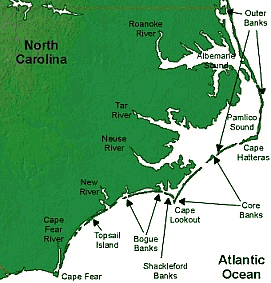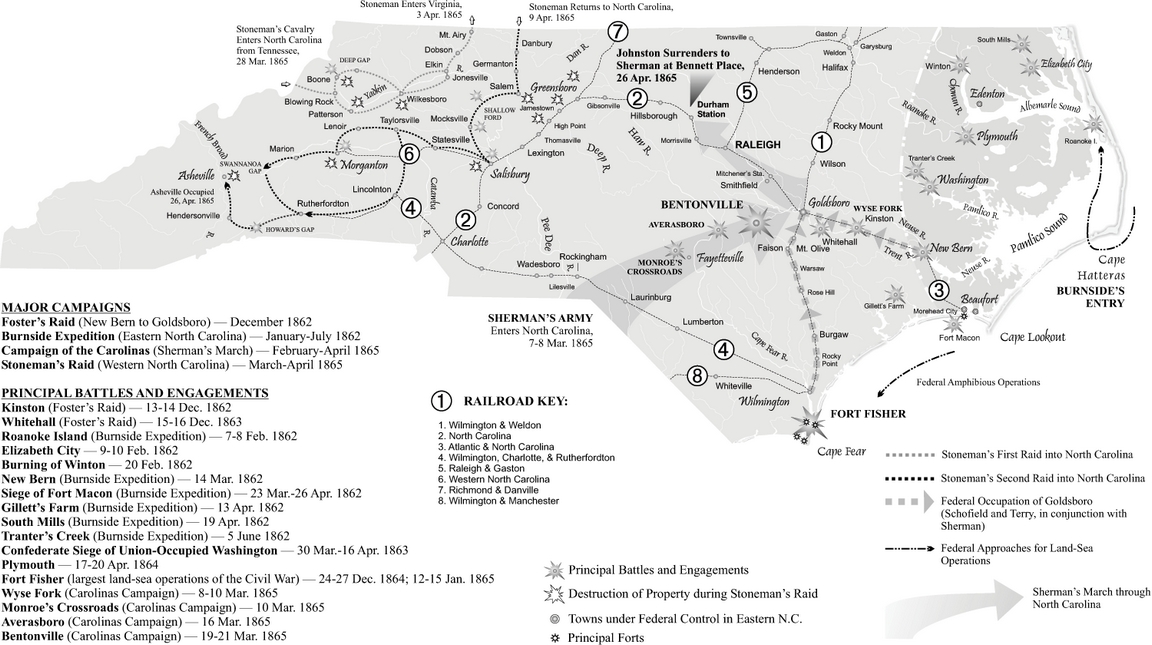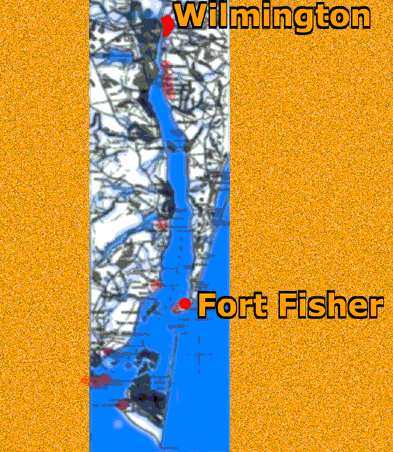|
North Carolina Coast and the Civil War Homepage
North Carolina Coast
and the Civil War
The American Civil
War was fought in many places across the southern landscape, but perhaps no region held as much importance to the Union's Anaconda Plan as eastern North Carolina. Control of the sounds and rivers of North Carolina was vital to cutting off the Confederacy's southern supply routes to Virginia.
As the Federal government tightened its blockade, rapidly raising the number of its ships from 42 in 1861 to 671 in 1864,
it viewed "the necessity of possessing the North Carolina sounds as well as its Outer Banks." To accomplish its objectives,
the Union command, with combined land and naval forces, launched a series of expeditions, campaigns, and operations against
the North Carolina coast. (North Carolina Coast and the American Civil War:
Operations, Campaigns, and Expeditions.)
| Civil War on the North Carolina Coast Map |

|
| Most Civil War battles were fought along North Carolina's coast |
| North Carolina Coast Civil War Map |

|
| North Carolina Civil War Coast Battle Map |
Early in the war, "General Robert E. Lee was fearful that General Ambrose
Burnside would find out the defenseless condition of North Carolina and move forward. Every night General Lee telegraphed:
'Any movement of the enemy in your front to-day?'"
At the close of 1862, only two regiments of infantry were left in North Carolina, the Fiftieth and
Fifty-first, and the Union forces on the coast could, had they been apprised of the heavy movement of troops, "have swept
without opposition over all the State. A people less brave and less patriotic would never have consented to incur such a risk
with so strong an enemy at its doors. The governor exposed his own capital to save that of the Confederacy." At the close
of the Civil War, consequently, North Carolina had "forty regiments in Virginia."
In an effort to alleviate the state of affairs at the opening
of 1864, a force of magnitude was sent to North Carolina. General George Pickett, a well-known soldier of great zeal and valor,
with a division of troops, advanced to the State to assist the forces already there.
The close of 1863 was gloomy enough in eastern North Carolina.
Moore thus describes it: "The condition of eastern North Carolina grew hourly more deplorable. Frequent incursions of the
enemy resulted in the destruction of property of all kinds. Especially were horses and mules objects of plunder. Pianos and
other costly furniture were seized and sent North, while whole regiments of 'bummers' wantonly defaced and ruined the fairest
homesteads in eager search for hidden treasure. The 'buffaloes,' in gangs of a dozen men, infested the swamps and made night
hideous with their horrid visitations. They and their colored coadjutors, by all manner of inducements, enticed from the farms
such of the negro men as were fitted for military duty....To the infinite and undying credit of the colored race, though the
woods swarmed with negro men sent back on detailed duty for the purpose of enlisting their comrades in the Federal army, there
were less acts of violence toward the helpless old men, women and children than could have been possibly expected under the
circumstances."
| Map of North Carolina and Civil War on the Coast |

|
| Civil War Battles Fought in North Carolina Map |
General
Lee said if Fort Fisher fell he could not subsist his army.
In
January 1865, after a failed attempt in December 1864, "the U.S. navy department was able to concentrate before Fort Fisher
a larger force than had ever before assembled under one command in the history of the American navy--a total of nearly sixty
vessels."
"All
day and all night on the 13th and 14th of January 1865," says Confederate Colonel Lamb, "the Union fleet kept up a ceaseless
and terrific bombardment....It was impossible to repair damage at night. No meals could be prepared for the exhausted garrison;
the dead could not be buried without new casualties. Fully 200 had been killed during these two days, and only three or four
of the land guns remained serviceable."
No
effort of any importance seems to have been made by the commanding general, Braxton Bragg, to assist the doomed fort.
“Then the massive land forces approached nearer and nearer by pits and shelter, and Colonel Lamb, and all their officers
and men fight for the important fort; frequently did they signal for the aid they sorely needed.”
General
Whiting, a most gallant and noble soldier, and Colonel Lamb, a determined veteran and warrior, were both severely wounded.
On the 15th of January, after exhausting every energy, Fort Fisher was surrendered. The Federal loss is stated at 1,445.
The Confederate garrison lost about 500. Few more gallant defenses against such odds are recorded. General Whiting died shortly
after in a Northern prison, and North Carolina soon witnessed that great Battle of Bentonville--the
largest battle fought in North Carolina and the last full-scale Confederate offensive--and then the nation experienced
the Reconstruction Era.
| North Carolina Coast Civil War Map |

|
| Civil War North Carolina Coast Map of Forts |
North Carolina and the American Civil War
Recommended Reading: The Civil War on the Outer Banks: A History of the Late Rebellion Along the Coast of North Carolina from Carteret to Currituck With Comments on Prewar Conditions and an Account of (251 pages). Description:
The ports at Beaufort, Wilmington, New Bern and Ocracoke, part of the Outer Banks (a chain of barrier islands that sweeps
down the North Carolina coast from the Virginia Capes to Oregon Inlet), were strategically vital for the import of war
materiel and the export of cash producing crops. From official records, contemporary newspaper accounts, personal journals
of the soldiers, and many unpublished manuscripts and memoirs, this is a full accounting of the Civil War along the North Carolina coast.
Recommended Reading: Ironclads and Columbiads: The Coast (The Civil War in North Carolina)
(456 pages). Description: Ironclads and Columbiads
covers some of the most important battles and campaigns in the state. In January 1862, Union forces began in earnest to occupy
crucial points on the North Carolina coast. Within six months,
Union army and naval forces effectively controlled coastal North Carolina from the Virginia line south to present-day Morehead
City. Union setbacks in Virginia, however, led to the withdrawal of many
federal soldiers from North Carolina, leaving only enough Union troops to hold a few coastal strongholds—the vital ports
and railroad junctions. The South during the Civil War, moreover, hotly contested the North’s ability to maintain its
grip on these key coastal strongholds.
Recommended
Reading:
Storm over Carolina: The Confederate Navy's Struggle for Eastern North Carolina.
Description: The struggle for control of the eastern waters of North Carolina
during the War Between the States was a bitter, painful, and sometimes humiliating one for the Confederate navy. No better
example exists of the classic adage, "Too little, too late." Burdened by the lack of adequate warships, construction
facilities, and even ammunition, the South's naval arm fought bravely and even recklessly to stem the tide of the Federal
invasion of North Carolina from the raging Atlantic. Storm
Over Carolina is the account of the Southern navy's struggle in North Carolina
waters and it is a saga of crushing defeats interspersed with moments of brilliant and even spectacular victories. It
is also the story of dogged Southern determination and incredible perseverance in the face of overwhelming odds. Continued
below...
For most of the Civil War,
the navigable portions of the Roanoke,
Tar, Neuse, Chowan, and Pasquotank rivers were occupied by Federal forces. The Albemarle
and Pamlico sounds, as well as most of the coastal towns and counties, were also under Union control. With the building of
the river ironclads, the Confederate navy at last could strike a telling blow against the invaders, but they were slowly overtaken
by events elsewhere. With the war grinding to a close, the last Confederate vessel in North
Carolina waters was destroyed. William T. Sherman was approaching from the south, Wilmington was lost, and the Confederacy reeled as if from a mortal blow. For the Confederate
navy, and even more so for the besieged citizens of eastern North Carolina,
these were stormy days indeed. Storm Over Carolina describes their story, their struggle, their history.
Recommended Reading:
The Civil War in Coastal North Carolina (175 pages) (North Carolina Division of Archives and History). Description: From the drama of blockade-running to graphic descriptions of battles on the state's islands and
sounds, this book portrays the explosive events that took place in North Carolina's
coastal region during the Civil War. Topics discussed include the strategic importance of coastal North Carolina, Federal occupation of coastal areas, blockade-running, and the impact of
war on civilians along the Tar Heel coast.
Recommended Reading: The Civil War in the Carolinas (Hardcover). Description: Dan Morrill relates the experience of two quite different states bound together in the defense
of the Confederacy, using letters, diaries, memoirs, and reports. He shows how the innovative operations of the Union
army and navy along the coast and in the bays and rivers of the Carolinas affected the general
course of the war as well as the daily lives of all Carolinians. In the latter part of the war, he describes how Sherman's operation cut out the heart of the last stronghold of the
South. Continued below...
The author
offers fascinating sketches of major and minor personalities, including the new president and state governors, Generals Lee,
Beauregard, Pickett, Sherman, D.H. Hill, and Joseph E. Johnston. Rebels and abolitionists, pacifists and unionists, slaves
and freed men and women, all influential, all placed in their context with clear-eyed precision. If he were wielding a needle
instead of a pen, his tapestry would offer us a complete picture of a people at war.
Includes: History of North Carolina Coast American Civil War, List of all North Carolina Civil
War Battles and Battlefields Summary, Results, North Carolina Civil War Facts, Details, Battlefield Maps, map, Photos,
Picture, Photographs
|

